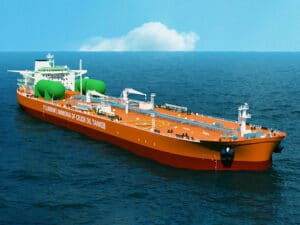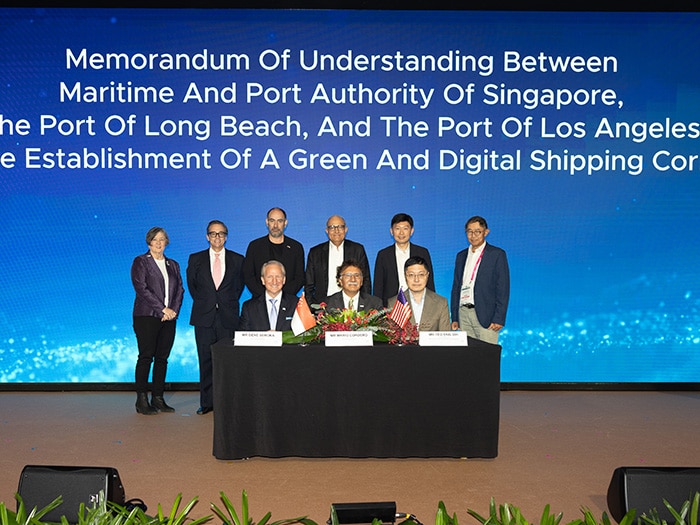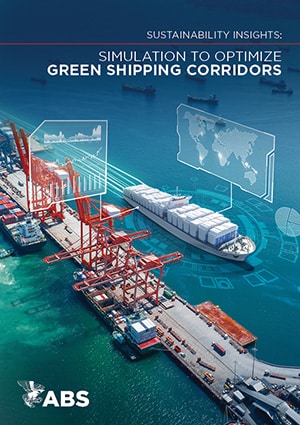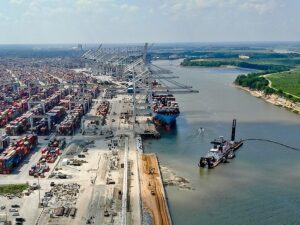
Green shipping corridor plans move forward
Written by Nick Blenkey
Green shipping corridor MoU was signed by (L to R at table) Port of Los Angeles executive director Gene Seroka, Port of Long Beach executive director Mario Cordero and MPA chief executive Teo Eng Dih.
Two developments today give hope that green shipping corridors are starting to move closer to reality. The long in the works plan for a green corridor linking California’s San Pedro Bay ports and Singapore has taken a step forward and ABS has launched a simulation service that could help the multiple players involved in green corridor planning reach key decisions.
Today saw the formal signing of a memorandum of understanding (MoU) by the Maritime and Port Authority of Singapore (MPA), the Port of Los Angeles (POLA), and the Port of Long Beach (POLB).
The MoU was signed by MPA chief executive Teo Eng Dih, Port of Los Angeles executive director Gene Seroka, and Port of Long Beach executive director Mario Cordero.
The aim is to establish a green and digital shipping corridor between the three global hub ports, which are vital nodes on the trans-Pacific shipping lane and key stakeholders in the maritime sector’s green transition. Ahead of the revision of the International Maritime Organization (IMO)’s Initial Strategy for the Reduction of Greenhouse Gas (GHG) Emissions from Ships in July 2023, the three ports will come together with other stakeholders in the maritime and energy value chains, to jointly accelerate the decarbonization of the maritime industry in line with the goals of IMO, and Singapore’s and the United States’ respective Nationally Determined Contributions under the Paris Agreement on climate change.
The green and digital corridor is being facilitated by the C40 Cities, a network of nearly 100 mayors of the world’s leading cities who are working to deliver the urgent action needed to confront the climate crisis and who are committed to using a science-based and people-focused approach to help the world limit global heating to 1.5°C, The current chair of C40 is Mayor of London Sadiq Khan while three-term Mayor of New York City Michael R. Bloomberg serves as President of the Board. Bloomberg Philanthropies is one of C40’s three strategic funders.
The green and digital shipping corridor aims to support the transition to low- and zero-emission fuels by ships calling at Singapore and the San Pedro Bay port complex. The parties will work to facilitate the supply and adoption of these fuels and explore the necessary infrastructure and regulations for bunkering. In addition to identifying and collaborating on pilot and demonstration projects, the MoU aims to identify digital shipping solutions and develop standards and best practices for green ports and the bunkering of alternative marine fuels, including sharing experiences at international platforms such as IMO.
- More on the MoU and the background to its signing HERE
GREEN CORRIDORS SIMULATION
There are green shipping corridor plans in the works worldwide and ABS has launched a new simulation service that uses an advanced modeling capability to provides a detailed simulation of the complex nexus of stakeholders involved in corridor development, providing the data required to support policy and investment decisions.
“Green shipping corridors will be at the heart of any successful movement to decarbonize our industry. But these initiatives require advanced analysis beginning at the pre-feasibility stage through the full lifecycle of corridor development. With assets and operations from multiple stakeholders and a wide range of operational, policy, and regulatory issues to consider, simulation and optimization tools are ideal for providing critical analysis that accounts for uncertainties of the many variables affecting corridor design,” said Christopher Wiernicki, ABS chairman, president and CEO. “ABS’ simulation technology offers the fidelity of a digital twin, or digital sandbox if you prefer, shaping key decisions across the entire range of stakeholders by evaluating a range of transition path options and alternative future fuel scenarios to determine the best approach for a specific corridor. This includes macro-level corridor design issues with the stakeholder coalition and stakeholder-specific decisions by fuel suppliers, port authorities and terminal operations, vessel owners and operators, and cargo owners and shippers.”

Complementing the modeling and simulation service is a new ABS publication, An Approach to Green Shipping Corridor Modeling and Optimization, exploring two green shipping corridor case studies: the Singapore-Rotterdam containership initiative and the Australia-Japan iron ore bulk carrier proposal.
“Computer-based modeling and simulation is one of the most effective methods to address system complexities, and ABS is leveraging our extensive capabilities in advanced optimization and modeling to support clients and industry stakeholders to accurately evaluate the performance of potential green corridors,” said Dr. Gu Hai, ABS Vice President and the Head of ABS’ Global Simulation Center based in Singapore.
The outcomes of the studies provide a common model for data-driven decision making. The model is capable of generating a broad range of rich data including fleet fuel mix, newbuilding vessel investment needs, annualized port investments, fuel demand prediction in specific ports, fuel storage requirements at specific ports, and year-over-year fuel procurement for port bunkering stations and more.
- Download the new ABS publication HERE




